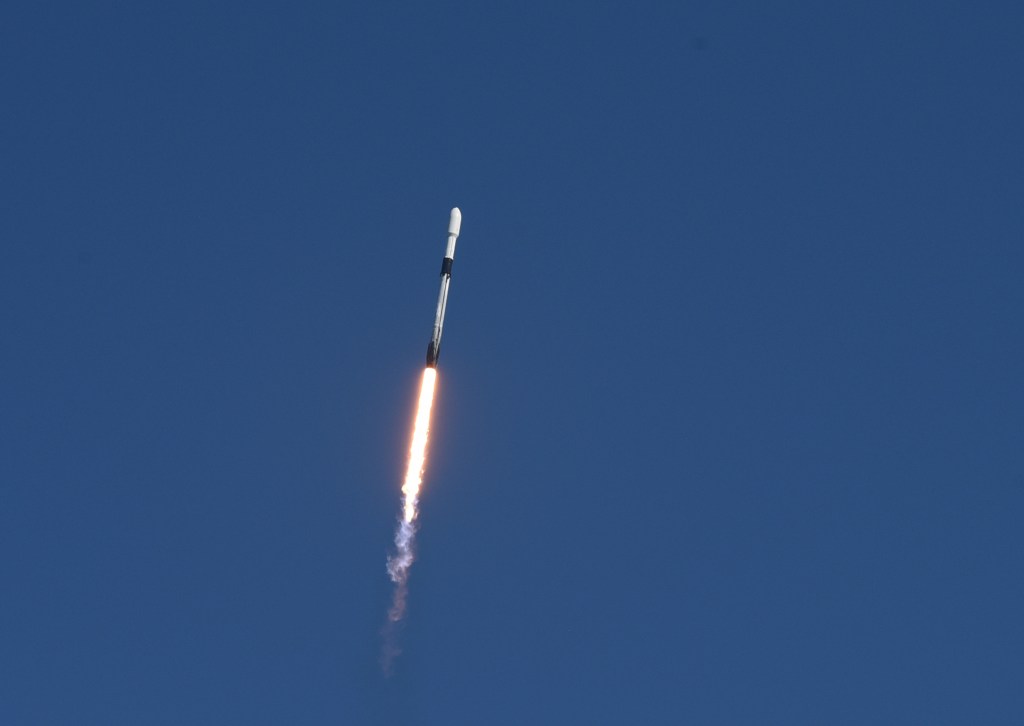Part of a rocket launched by Elon Musk’s company, SpaceX, in 2015, is expected to slam into the Moon in a matter of weeks.
The object is a second stage, which is a section that has been separated from the bottom of the rocket, known as the first stage, equipped with its own engines and propellant. Rockets are made up of stages that detach from one another at different locations in the Earth’s atmosphere and in space, and the remains become debris.
Videos by VICE
The Falcon 9 rocket was launched in February of 2015 and deployed NASA’s Deep Space Climate Observatory one-million miles from Earth. After separation, the rocket’s second stage lacked the fuel to return to Earth’s atmosphere and the energy to escape the Earth-Moon system, so it has been orbiting around earth ever since. It’s currently in high Earth orbit, an orbital range greater than 36,000 miles from Earth’s surface, and on course to collide with the moon on March 4 according to astronomer Bill Gray, an author of space object-tracking software who wrote about the rocket in a blog post last week.
According to Gray, it will be the first time in history that a human-made object has unintentionally hit the Moon.
Gray told Motherboard he’s been tracking the rocket and its remnants since deployment in 2015. It’s one of “a dozen or so objects, mostly junk,” in very high orbit around the earth that he has his eye on, he said. He monitors these objects not out of concern for the safety of our solar system, but because they interfere with surveys of potentially destructive asteroids that he conducts for his day job.
“It’s been sort of a bit of a nuisance from the standpoint of the surveys,” he said of the Falcon 9. “We tend to keep track of it. Nobody else really has much reason to. There’s a lot of attention paid to objects that are in lower Earth orbit, because they might hit a valuable spacecraft or the International Space Station. This object is high enough that nobody really cares about it unless you’re an asteroid observer.”
He first spotted the chance of the Falcon stage’s collision earlier this month, at which point he put out a call for other observations of it from other astronomers, all of whom corroborated his prediction, which he later detailed on his blog. The “first unintended lunar impact” by space junk, “period,” he wrote, will take place on March 4 at 7:25 a.m. EST, plus or minus a few minutes.
Impact is “certain,” he wrote. But it’s not anything to fear, he told Motherboard over the phone. Indeed, social media has been awash with people expressing worry about what affect the impact may have. “It is (I believe) the first time that man made debris of any significance has unintentionally collided with a significant body in the solar system. And of course it will infinitesimally affect our Moon’s orbit,” one user predicted.
The second stage is four metric tons, and is slated to hit the moon at 2.58 kilometers-per-second—it will likely create a crater on the moon, but little else, and, Gray says, rocks of much larger size hit the moon at higher speeds all the time.
“The level of concern for objects of this sort is low in the sense that, as far as I know, nobody but me even bothers tracking it,” he said.
Though likely the first to occur by accident, it’s not the first time a spacecraft has hit the moon. Famously, pieces of Apollo crafts were deliberately crashed into the Moon to calibrate seismometers placed on the surface for scientific reasons.
Even so, the collision raises questions about what we do with so-called “space junk,” like stages of rockets that are no longer useful, once they’re launched. First stages, or the segments at the bottom of a rocket, typically burn up in the atmosphere or return to Earth safely, but second stages, which detach at a higher orbit, are at risk of getting caught in a chaotic orbit near the Moon. Gray believes the eventuality that this “space junk” lands on the Moon is a best-case scenario compared to the possibility that it continues to travel through space chaotically for decades.
“Disposing of these things by having them hit the moon seems like a perfectly good way of getting rid of them to me,” Gray said. “I hope that we will get some scientific information from this impact.”
SpaceX did not respond to Motherboard’s request for comment.
More
From VICE
-

Good news: If these things come too close, we can blast them out of the sky. Photo: NASA/ZUMA Press Wire Service/Shutterstock -

-

-

Photo by The LIFE Picture Collection/Shutterstock

